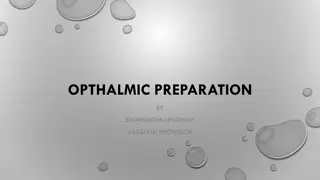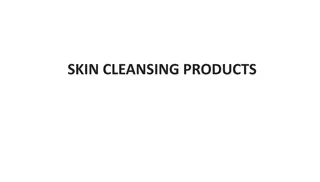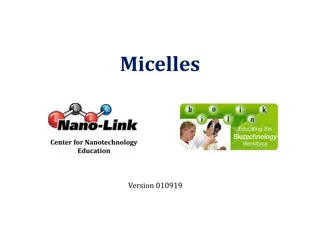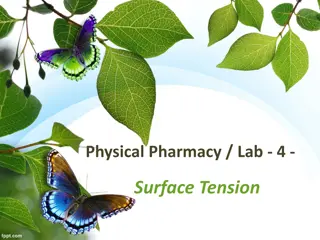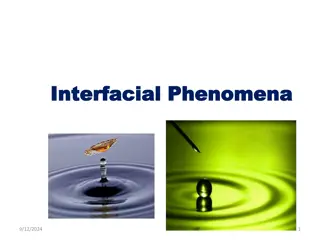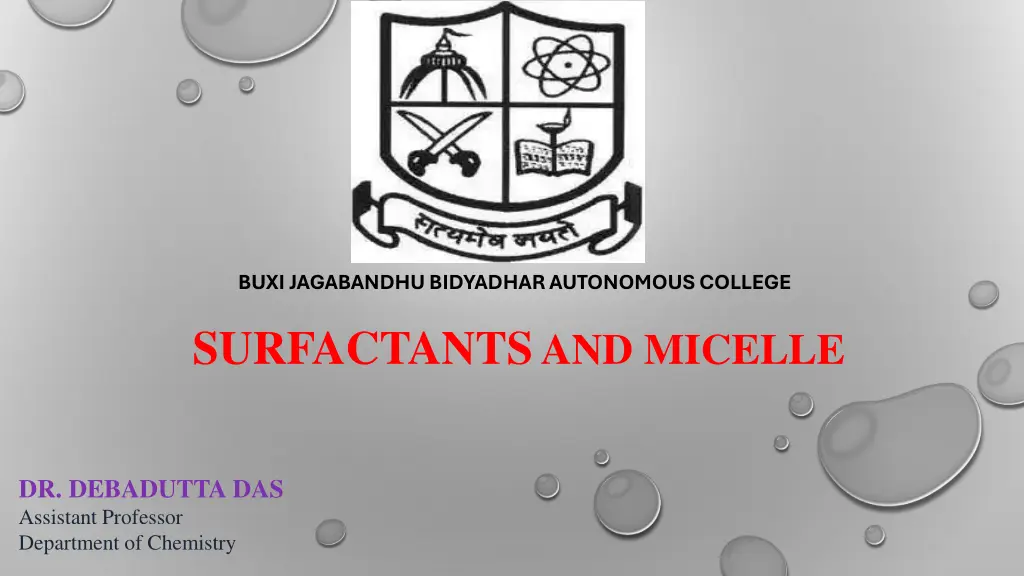
Structure and Applications of Surfactants and Micelles in Chemistry
Explore the world of surfactants and micelles in chemistry, including their structures, classifications, applications in various industries, and the science behind micelle formation. Dive into the fascinating properties of these surface-active agents and their roles in different products, from shampoos to cosmetics.
Download Presentation

Please find below an Image/Link to download the presentation.
The content on the website is provided AS IS for your information and personal use only. It may not be sold, licensed, or shared on other websites without obtaining consent from the author. If you encounter any issues during the download, it is possible that the publisher has removed the file from their server.
You are allowed to download the files provided on this website for personal or commercial use, subject to the condition that they are used lawfully. All files are the property of their respective owners.
The content on the website is provided AS IS for your information and personal use only. It may not be sold, licensed, or shared on other websites without obtaining consent from the author.
E N D
Presentation Transcript
BUXI JAGABANDHU BIDYADHAR AUTONOMOUS COLLEGE SURFACTANTS AND MICELLE DR. DEBADUTTA DAS Assistant Professor Department of Chemistry
CONTENTS SURFACTANTS STRUCTURE OF SURFACTANTS CLASSIFICATION OF SURFACTANTS APPLICATION OF SURFACTANTS MICELLE CRITICAL MICELLE CONCENTRATION SHAPE AND SIZE OF MICELLE STRUCTURE OF MICELLE
SURFACTANTS Surfactants are surface active agents. These compounds lower the surface tension by their tendency to get adsorbed at surface and interfaces. Interface is a link of two immiscible phases For e.g. Solid - Vapour (surface) Solid Liquid (interface) Solid Solid (interface) Liquid Vapour (surface) fig. 1 Adsorption of surfactants at the surface of water
STRUCTURE Surfactants are amphiphilic These compounds have 2 parts: (a) lipophilic: soluble in fluid (b) lipophobic: insoluble in liquid The hydrophilic part is denoted as the head The hydrophobic part is denoted as the tail The hydrophobic part is generally linear or branched chain of 8 to 18 carbon which can be either aliphatic or aromatic; sometimes both. The sources of hydrophobic part are oils, fats or fig. 2 Diagrammatic illustration of surfactant synthetic alcohol.
CLASSIFICATION Surfactants are mainly of 4 types on the basis of the charge on the polar head group. Non-Ionic Anionic Cationic Zwitterionic
Anionic surfactant: . Anionic functional group at their head i.e. sulphate, sulphonate, phosphate, carboxylate .Mostly used in detergents Cationic surfactant: .The hydrophilic part is positively charged. . This group contains no wash activity but has corrosion inhibitory effects. Non-Ionic surfactant: . The hydrophilic part is non-ionic. These are insensitive to water hardness. Zwitterionic surfactant: . These contain two oppositely charged groups. Also known as amphoterics . These have excellent dermatological properties.
APPLICATIONS Shampoos Detergents Conditioners Fabric softeners Contact lens cleaners Cosmetics Biocides (sanitizers) Emulsions Adhesives Ore floatation Water repellence
MICELLE A micelle is a structure formed by the aggregation of surfactant molecules in a liquid, usually water. These molecules have hydrophilic (water-attracting) heads and hydrophobic (water-repelling) tails. When mixed in water, they arrange themselves so that the hydrophobic tails face inward, away from the water, while the hydrophilic heads face outward, interacting with the water.
Representation of a micelle in aqueous solution Representation of a spherical micelle for dodecyl sulphate.
CRITICAL MICELLE CONCENTRATION CMC i.e critical micelle concentration. The critical micelle concentration (CMC) is explained as the concentration of surfactants above which micelles are formed and all additional surfactants are added in the system so as to go to the micelles. The CMC is the accurate flocking of surfactants at which aggregates become thermodynamically soluble in an liquid solution. There is no high density of surfactant below the CMC which immediately precipitate into a separate t phase. Above the CMC, the solubility of the surfactant in the aqueous solution go beyond.. The energy which is required to keep the surfactant in the solution is no longer in the e lowest energy state. To decrease the system free energy the surfactant is precipitated.
The Critical Micelle Concentration (CMC) is influenced by several factors, including: 1.Nature of Surfactant: a. Chain Length: Longer hydrophobic tails typically lower the CMC due to increased hydrophobic interactions. b. Hydrophilic Head Group: The size and charge of the head group affect solubility and aggregation behavior. 2.Temperature: CMC usually decreases with increasing temperature for nonionic surfactants. However, the trend can vary for ionic surfactants due to changes in hydrophilicity. 3.Ionic Strength: The presence of salts can decrease the CMC of ionic surfactants by screening electrostatic repulsions between charged head groups, promoting micelle formation. 4.pH of the Solution: For ionic surfactants, the degree of ionization of the head group can change with pH, affecting the CMC. This is particularly relevant for surfactants with carboxylic acid or amine groups.
5.Presence of Co-Surfactants: 1.Adding other surfactants can either raise or lower the CMC, depending on their interactions. Mixed micelles may form, which can alter the overall CMC of the system. 6. Solvent Properties: 1.The polarity and dielectric constant of the solvent can influence CMC. For example, in organic solvents or mixed solvents, the CMC may change significantly compared to pure water. 7.Additives: 1.Other compounds, such as polymers or lipids, can influence micelle formation and stability, thereby affecting the CMC.
SHAPES OF MICELLE Spherical Micelles: The most common shape, where surfactant molecules form a spherical structure with hydrophilic heads facing outward and hydrophobic tails inward. Cylindrical Micelles: Formed when surfactants have longer hydrophobic tails. In this configuration, the micelles resemble elongated cylinders rather than spheres Lamellar Micelles: Characterized by a layered structure, where surfactant molecules organize into sheets. This shape can occur at higher surfactant concentrations. Reverse Micelles: inverse micelles, are structures formed in nonpolar solvents (like oils) where the surfactant molecules arrange themselves in a way that the hydrophobic tails point outward and the hydrophilic heads point inward. This creates a spherical or oval structure with a hydrophilic core that can solubilize polar substances, such as water or polar solutes Vesicular Micelles: These structures can encapsulate a volume of solvent, forming a bilayer similar to cell membranes, but they are larger than typical micelles. Bicontinuous Micelles: Bicontinuous micelles are complex structures that consist of two interpenetrating continuous domains of surfactant and solvent. In this type of micelle, both the hydrophilic (water-loving) and hydrophobic (water- repelling) regions coexist in a single structure, creating a network that allows for the transport of both polar and nonpolar substances
Self-assembly of surfactant leads to a domain of different structures as we will discuss now: (a) Spherical micelles with its interior is formed of the hydrocarbon chains and the polar head group surface which is covering water . The radius of the hydrocarbon core is close to alkyl chain length . (b) Cylindrical micelles with its interior is formed of the hydrocarbon chains and polar head groups surface water surface . The cross-section of hydrocarbon core is identical r to that of spherical micelles. The micelle length is fluctuating so these micelles are polydisperse. (c) Surfactants bilayers which is build up of lamellar liquids crystals have surfactantwater system having a hydrocarbon core of thickness of 80% of the length of two extended alkyl chains. (d) Reversed or inverted micelle has core of water that is covered by the polar head groups surfactants . The alkyl chains together with a non-polar solvent make up the continuous medium. Like normal micelle they can reproduce into cylindrical form.
(e) A bicontinuous structure having the surfactant molecules assembled into connected films. (f) Vesicles are built from bilayer like those of the lamellar phase and are featured by two distinct water compartments, one producing the core and one the external medium. Vesicles may have different shape and there are also reversed-type vesicles.
(a)The inner part of the micelle, i.e a hydrophobic core is formed of the hydrocarbon chain of the surfactant molecule. It s radius is approximately of the range of fully extended hydrophobic chain shown in the fig (b) A Stern layer covering the core, is part of electrical double layer, which have coordinated shell of hydrophilic head groups with (1 - )N counter ions, where is the degree of ionisation and N is the aggregation number (number of molecules in the micelle). the degree of ionisation for most of the ionic micelles is between 0.2 and 0.3; that is, 70 - 80% of the counter ions may be treated as they are bound to the micelles . (c) The Gouy-Chapman portion of electrically two layer is diffused and surrounds the Stern layer, it comprises of the N counter ions that are needed to neutralise the charge on the micelle. The thickness of the double layer is the ionic strength function the solution and is can be highly reduced in the presence of electrolyte.

